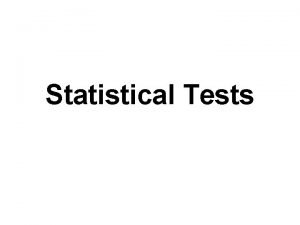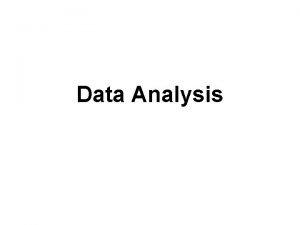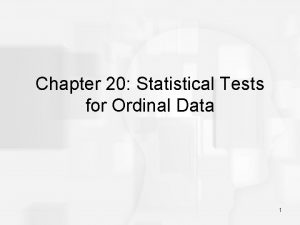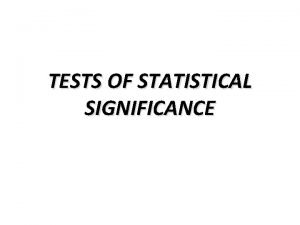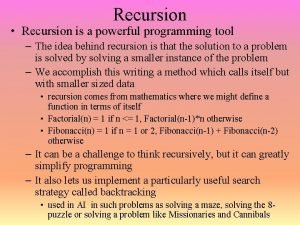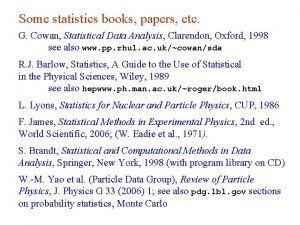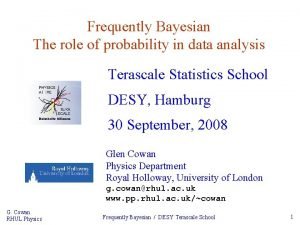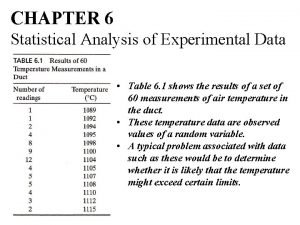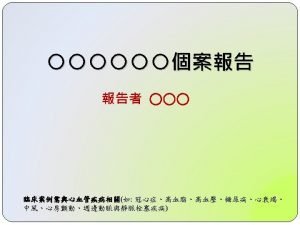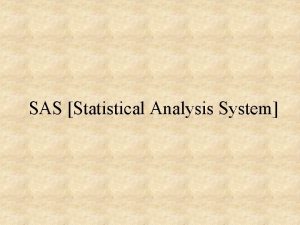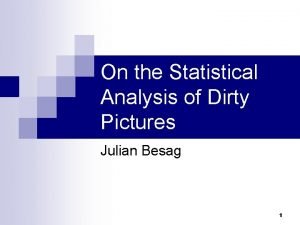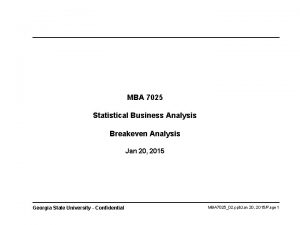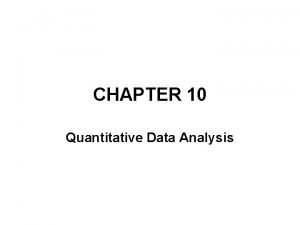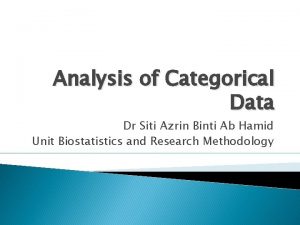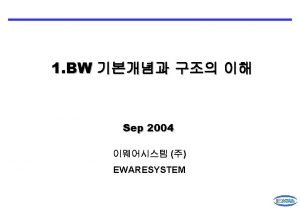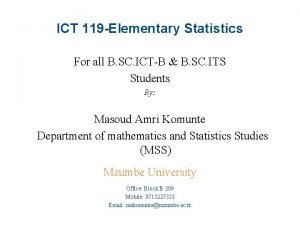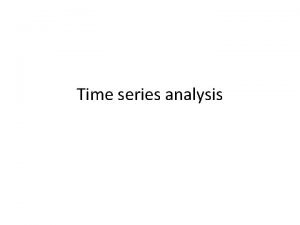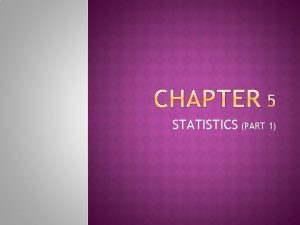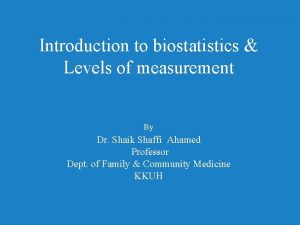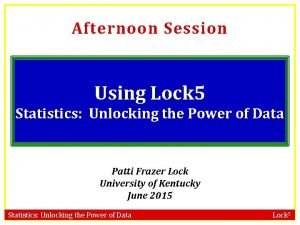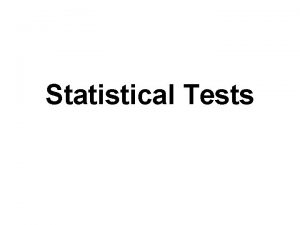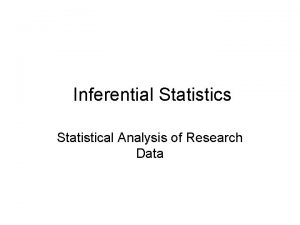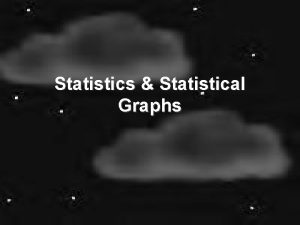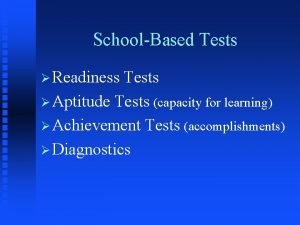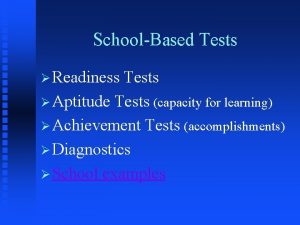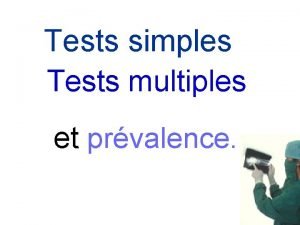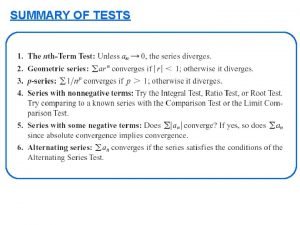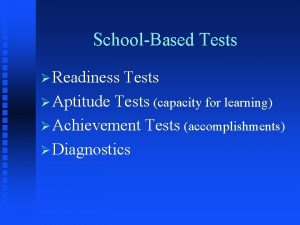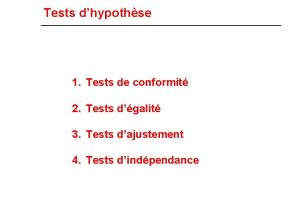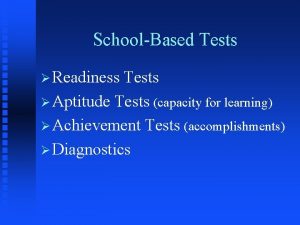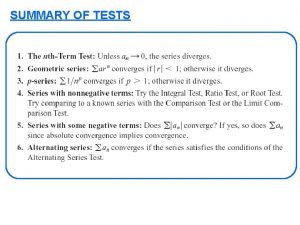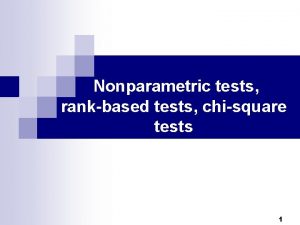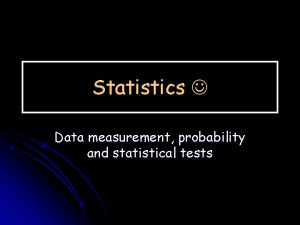Statistical Tests Data Analysis Statistics a powerful tool



































- Slides: 35

Statistical Tests

Data Analysis Statistics - a powerful tool for analyzing data 1. Descriptive Statistics - provide an overview of the attributes of a data set. These include measurements of central tendency (frequency histograms, mean, median, & mode) and dispersion (range, variance & standard deviation) 2. Inferential Statistics - provide measures of how well your data support your hypothesis and if your data are generalizable beyond what was tested (significance tests)

Inferential Statistics

The Population: =5. 314 Population size = 500

The Population: =5. 314 The Sample: 7, 6, 4, 9, 8, 3, 2, 6, 1 mean = 5. 111

The Population: =5. 314 The Sample: 1, 5, 8, 7, 4, 1, 6, 6 mean = 4. 75

Parametric or Non-parametric? • Parametric tests are restricted to data that: 1) show a normal distribution 2) * are independent of one another 3) * are on the same continuous scale of measurement • Non-parametric tests are used on data that: 1) show an other-than normal distribution 2) are dependent or conditional on one another 3) in general, do not have a continuous scale of measurement e. g. , the length and weight of something –> parametric vs. did the bacteria grow or not grow –> non-parametric

The First Question After examining your data, ask: does what you're testing seem to be a question of relatedness or a question of difference? If relatedness (between your control and your experimental samples or between you dependent and independent variable), you will be using tests for correlation (positive or negative) or regression. If difference (your control differs from your experimental), you will be testing for independence between distributions, means or variances. Different tests will be employed if your data show parametric or non-parametric properties. See Flow Chart on page 50 of HBI.


Tests for Differences • Between Means - t-Test - P - ANOVA - P - Friedman Test - Kruskal-Wallis Test - Sign Test - Rank Sum Test • Between Distributions - Chi-square for goodness of fit - Chi-square for independence • Between Variances - F-Test – P P – parametric tests

Differences Between Means Asks whether samples come from populations with different means Null Hypothesis Y Alternative Hypothesis Y A B C There are different tests if you have 2 vs more than 2 samples

Differences Between Means – Parametric Data t-Tests compare the means of two parametric samples E. g. Is there a difference in the mean height of men and women? HBI: t-Test Excel: t-Test (paired and unpaired) – in Tools – Data Analysis

A researcher compared the height of plants grown in high and low light levels. Her results are shown below. Use a T-test to determine whethere is a statistically significant difference in the heights of the two groups

Differences Between Means – Parametric Data ANOVA (Analysis of Variance) compares the means of two or more parametric samples. E. g. Is there a difference in the mean height of plants grown under red, green and blue light? HBI: ANOVA Excel: ANOVA – check type under Tools – Data Analysis

A researcher fed pigs on four different foods. At the end of a month feeding, he weighed the pigs. Use an ANOVA test to determine if the different foods resulted in differences in growth of the pigs. weight of pigs fed different foods food 1 food 2 food 3 food 4 60. 8 68. 7 102. 6 87. 9 57. 0 67. 7 102. 1 84. 2 65. 0 74. 0 100. 2 83. 1 58. 6 66. 3 96. 5 85. 7 61. 7 69. 8 90. 3

Aplysia punctata – the sea hare

Aplysia parts

Differences Between Means – Non. Parametric Data The Sign Test compares the means of two “paired”, nonparametric samples E. g. Is there a difference in the gill withdrawal response of Aplysia in night versus day? Each subject has been tested once at night and once during the day –> paired data. HBI: Sign Test Excel: N/A


Differences Between Means – Non. Parametric Data The Friedman Test is like the Sign test, (compares the means of “paired”, non-parametric samples) for more than two samples. E. g. Is there a difference in the gill withdrawal response of Aplysia between morning, afternoon and evening? Each subject has been tested once during each time period –> paired data HBI: Friedman Test Excel: N/A


Differences Between Means – Non. Parametric Data The Rank Sum test compares the means of two nonparametric samples E. g. Is there a difference in the gill withdrawal response of Aplysia in night versus day? Each subject has been tested once, either during the night or during the day –> unpaired data. HBI: Rank Sum Excel: N/A


Differences Between Means – Non. Parametric Data The Kruskal-Wallis Test compares the means of more than two non-parametric, non-paired samples E. g. Is there a difference in the gill withdrawal response of Aplysia in night versus day? Each subject has been tested once, either during the morning, afternoon or evening –> unpaired data. HBI: Kruskal-Wallis Test Excel: N/A


Differences Between Distributions Chi square tests compare observed frequency distributions, either to theoretical expectations or to other observed frequency distributions.

Differences Between Distributions E. g. The F 2 generation of a cross between a round pea and a wrinkled pea produced 72 round individuals and 20 wrinkled individuals. Does this differ from the expected 3: 1 round: wrinkled ratio of a simple dominant trait? Frequency E E Smooth Wrinkled HBI: Chi-Square One Sample Test (goodness of fit) Excel: Chitest – under Function Key – Statistical

Differences Between Distributions E. g. 67 out of 100 seeds placed in plain water germinated while 36 out of 100 seeds placed in “acid rain” water germinated. Is there a difference in the germination rate? Proportion Germination Null Hypothesis Plain Acid Proportion Germination Alternative Hypothesis Plain Acid HBI: Chi-Square Two or More Sample Test (independence) Excel: Chitest – under Function key - Statistical

Correlations look for relationships between two variables which may not be functionally related. The variables may be ordinal, interval, or ratio scale data. Remember, correlation does not prove causation; thus there may not be a cause and effect relationship between the variables. E. g. Do species of birds with longer wings also have longer necks? HBI: Spearman’s Rank Correlation (NP) Excel: Correlation (P)

Question – is there a relationship between students aptitude for mathemathics and for biology? Student Math score Math Rank Biol. score Biology rank 1 57 3 83 7 2 45 1 37 1 3 72 7 41 2 4 78 8 84 8 5 53 2 56 3 6 63 5 85 9 7 86 9 77 6 8 98 10 87 10 9 59 4 70 5 10 71 6 59 4


Regressions look for functional relationships between two continuous variables. A regression assumes that a change in X causes a change in Y. E. g. Does an increase in light intensity cause an increase in plant growth? HBI: Regression Analysis (P) Excel: Regression (P)

Correlation & Regression Looks for relationships between two continuous variables Alternative Hypothesis Null Hypothesis Y Y X X

Is there a relationship between wing length and tail length in songbirds? wing length cm tail length cm 10. 4 7. 4 10. 8 7. 6 11. 1 7. 9 10. 2 7. 2 10. 3 7. 4 10. 2 7. 1 10. 7 7. 4 10. 5 7. 2 10. 8 7. 8 11. 2 7. 7 10. 6 7. 8 11. 4 8. 3

Is there a relationship between age and systolic blood pressure? Age (yr) systolic blood pressure mm hg 30 108 30 110 30 106 40 125 40 120 40 118 40 119 50 132 50 137 50 134 60 148 60 151 60 146 60 147 60 144 70 162 70 156 70 164 70 158 70 159
 A powerful tool in statistics
A powerful tool in statistics A powerful tool in statistics.
A powerful tool in statistics. Statistical tests for ordinal data
Statistical tests for ordinal data Ace different tests iq but make
Ace different tests iq but make Bmk+
Bmk+ Statistical tests psychology
Statistical tests psychology Statistical tests psychology
Statistical tests psychology Psychology statistical test table
Psychology statistical test table What is recursion can be a powerful tool for solving?
What is recursion can be a powerful tool for solving? Preserving statistical validity in adaptive data analysis
Preserving statistical validity in adaptive data analysis Cowan statistical data analysis pdf
Cowan statistical data analysis pdf State bayes theorem
State bayes theorem Statistical analysis of experimental data
Statistical analysis of experimental data Potter's wheel data cleaning tool
Potter's wheel data cleaning tool Introduction to statistics what is statistics
Introduction to statistics what is statistics Biochemical data, medical tests, and procedures (bd)
Biochemical data, medical tests, and procedures (bd) Statistical analysis system
Statistical analysis system Ascenex
Ascenex Multivariate statistical analysis
Multivariate statistical analysis Statistical business analysis
Statistical business analysis Marketing analytics software r
Marketing analytics software r Statistical treatment of data example
Statistical treatment of data example What statistical test for categorical data
What statistical test for categorical data Statistical data warehouse
Statistical data warehouse Statistical treatment of data example
Statistical treatment of data example Content analysis is a type of secondary data analysis
Content analysis is a type of secondary data analysis The main objectives of time series analysis
The main objectives of time series analysis Research procedure in methodology
Research procedure in methodology Data preparation and basic data analysis
Data preparation and basic data analysis Data acquisition and data analysis
Data acquisition and data analysis What is ungrouped data in statistics
What is ungrouped data in statistics Big data official statistics
Big data official statistics Nominal data example
Nominal data example Quartile formula
Quartile formula Lock 5 stat
Lock 5 stat Manifold classification example
Manifold classification example
